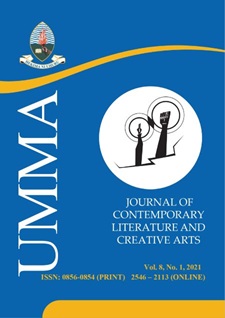Songs and Language: Children ' s Songs and the Learning of Kiswahili in Dar es Salaam, Tanzania
Abstract
This paper focuses on the use of children ' s songs in learning Kiswahili language in Dar es Salaam Tanzania. Usually, songs serve different purposes including transmission of knowledge, values, and language. It argues that children ' s songs serve as a means for learning Kiswahili and indigenous culture. The study was conducted at Msewe, Kimara and Changanyikeni nursery schools located in Ubungo municipality of Dar es Salaam. The data was collected using interviews, observations, discussion, and documentation. In this empirical research, the study analysed the Kiswahili songs, lyrics and associated information collected with the children at these schools. With recourse to the participant and arousal theory, the study found that, apart from learning word sounds and singing, songs help children to learn pronunciation and application of words found in songs in their day-to-day communication. The tunes and rhythms of these songs support the children ' s acquaintance with Kiswahili words. Furthermore, the songs ' lyrics enables children to construct Kiswahili sentences and structures, thereby enhances their learning of Kiswahili language. https://dx.doi.org/10.56279/ummaj.v9i2.3
References
Agawu, K. 2003, Representing African music, Routledge, New York.
Barz, G. 2011, Singing for life: songs of hope, healing, and HIV/AIDS in Uganda. Oxford: Oxford University Press.
Blacking, J. 2000, How musical is man? University of Washington Press, Seattle.
Gunderson, F. 2014a, Preface. The World of Music (New Series), vol. 3 no. 1 pp. 7-10
Gunderson, F. 2010, Sukuma labor songs from western Tanzania: ' We never sleep, we dream of farming ' , Brill, Leiden and Boston.
Hall- Heimbecker, S. 2013, Unity in diversity through music and language in Gambia, in Worship and mission for the global church: an ethnodoxology Handbook, William Carey, Pasaderia.
Hawn, M. and Hong, S. L. 2013, Cross-cultural communication through symbol, in Worship and mission for the global church: an ethnodoxology handbook. William Carey, Pasaderia.
Hebert, D. 2013, New theories and methods for ethnomusicology, in A Collection of Papers Presented at Ethnomusicology Symposium 2013 edited by Mathayo Ndomondo, Imani Sanga and Mitchel Strumpf, Dar es Salaam University Press, Dar es Salaam.
Isaacs, J. 2011, Singing in the shadow of death, in African musicians respond to a pandemic with songs of sorrow, resistance, advocacy and hope, Oxford University Press, Oxford.
Kidula, J. 2013, Music in Kenyan Christianity, Bloomington, Indiana.
Legère, K. 2013, Wedding songs of Dowe people eastern Tanzania, Bagamoyo district, in A collection of papers presented at ethnomusicology symposium 2013 edited by Mathayo Ndomondo, Imani Sanga and Mitchel Strumpf, Dar es Salaam University Press, Dar es Salaam.
Liwewa, E. 2009, " ' Music as an element of mizuka ' : a vehicle for healing among of the waMakonde of Mtwara rural district, Tanzania," MA Thesis, University of Dar es Salaam.
Mkallyah, K. 2016, Affect and effect of indigenous Tanzanian music tradition in Christian church worship in Tanzania. Ethnomusicology, vol. 60, no. 2 pp. 300-328
Mulindi, R. L. 1983, "Musical in loogoli culture," Master ' s Thesis, Belfast University, Ireland.
Musungu, G. 2016, Idiomatic arrangement and adaptation of indigenous folk songs, in Music cultures from Eastern Africa, TATAKI, University of Dar es Salaam, Tanzania.
Musungu, G. 2010, Elements of cross-cultural music composition: the creation of esidialo €“a Samia marriage suite, PhD Thesis, University of South Africa (UNISA).
Nketia, K. 1974, 1992, The music of Africa, Victor Gollancz, London & New York.
Ondieki, D. O. 2016, Contextualization of music at the Kenya music festival, in Music cultures from Eastern Africa edited by Imani Sanga and Mathayo Ndomondo, TATAKI, University of Dar es Salaam, Tanzania.
Sanga, I. 2010, Postcolonial cosmopolitan music in Dar es Salaam: Dr Remmy Ongala and the travelling sounds, African Studies Review, vol. 53, no. 3, pp.61-76.
Sanga, I. 2008, Music and nationalism in Tanzania: dynamics of national space in muziki wa injili in Dar es Salaam, Ethnomusicology, vol. 52, no. 1, pp. 52-84.
Sanga, I. 2006, Muziki wa injili: the temporal and spatial aesthetics of popular church music in Dar es Salaam (1980s - 2005), PhD Thesis, University of Kwazulu €“ Natal, South Africa.
Schein, E. 2010, Organizational culture and leadership, Jossey-Bass, San Francisco, CA.
Schrag, B. 2013, Worship in my language, in Worship and Mission for the Global Church: An Ethnodoxology Handbook, William Carey, Pasaderia.
Schrag, B and Krabill, J. 2013, How local artists can help communities reach their kingdom goals: a manual, William Carey, Pasaderia.
Songoyi, E. 1988, Commercialization: its impact on traditional dances, B.A University of Dar es Salaam, Trondheim, Bjorn Aksdal.
Titon, J. T. 2009, The music culture as a world of music. Clark Baxter: Belmont.
Yung, B. 2019, Exploring creativity in traditional music, in Year Book For Traditional Music, vol. 51, pp. 1-15.
Downloads
Published
Issue
Section
License
- Authors retain copyright and grant the journal right of first publication with the work simultaneously licensed under a Creative Commons Attribution License that allows others to share the work with an acknowledgement of the work's authorship and initial publication in this journal.
- Authors are able to enter into separate, additional contractual arrangements for the non-exclusive distribution of the journal's published version of the work (e.g., post it to an institutional repository or publish it in a book), with an acknowledgement of its initial publication in this journal.
- Authors are permitted and encouraged to post their work online (e.g., in institutional repositories or on their website) prior to and during the submission process, as it can lead to productive exchanges, as well as earlier and greater citation of published work (See The Effect of Open Access).



